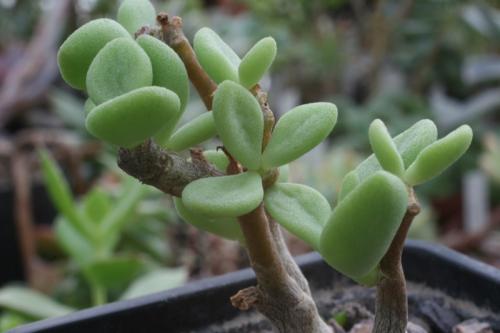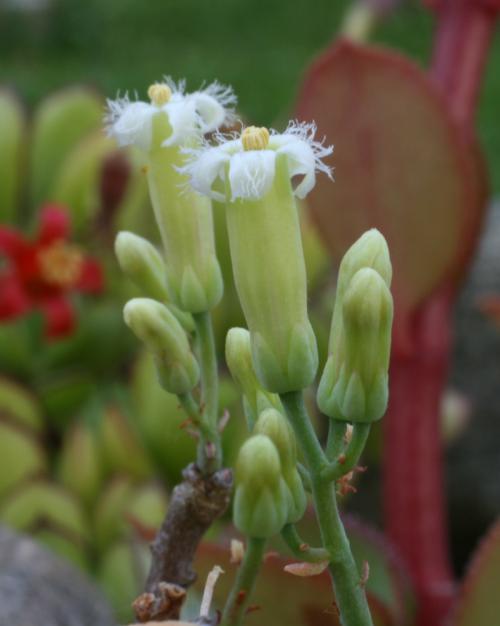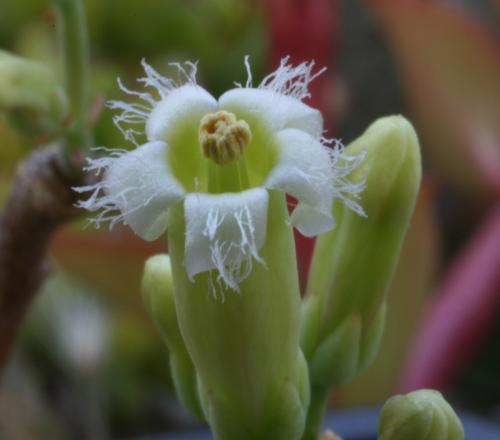BODLEYAE van Jaarsveld, 1992 (engl./ fr.)
Distribution : SA (Northern Cape : Southern Oograbies Mountains)
Description (by E. van Jaarsveld in IHSP, 2003) :
Dwarf erect sparingly branched succulents to 10 cm tall from a tuberous base to 6 cm in diameter with yellow-brown peeling bark.
Branches ascending, grey-green, with dark longitudinal striations, articulated at the nodes, younger branches 4 – 5 mm in diameter; phyllopodia short, truncate.
Leaves obovate to elliptic, 8 – 15 x 6 – 14 mm, green to pale green, sparingly glandular-hairy or glabrous, base cuneate, apex acute.
Inflorescences thyrses to 4 cm long with 1 – 2 monochasia each 1 -2 erect flowers, pedicels 6 – 16 mm, glandular-pubescent, bracts linear, acute, 1 – 1.5 mm.
Flower : Sepals triangular-lanceolate 3 x 1 mm, corolla 11 – 15 mm, tube funnel-shaped, yellowish-green, 3 mm in diameter at the base expanding to 4 mm at the throat, glandular-hairy, petals oblong, 5 x 2.5 mm, spreading, becoming recoiled, with long hairs on the inner surface.
Flowering time : Mid-summer.
Note :
The First Description was published in CSJ US 64(2):57-61 with the name of the new species as Tylecodon boddleyi. In vol.4 of the same year the following Note of Correction was published :
The name of the artist for whom Ernst van Jaarsveld named the new species of Tylecodon (see "Tylecodon boddleyi (Crassulaceae), a new species from the Northwestern Cape," this journal, Vol. 64, No. 2, March-April, 1992, pp. 57-61) is Elise Bodley, as it appears in the artist's signature on the beautiful color plate of the new taxon on page 58 (loc. cit.). The name was inadvertently misspelled throughout the paper and the epithet was mistakenly given a masculine ending. The correct orthographic spelling of this new species must be Tylecodon bodleyae. We thank Daryl Koutnik for bringing this to our attention.
--------------------------------------------------------------------------------------------------------------------
Distribution : Afrique du Sud (Cap-Nord : Augrabies du sud).
Description (par E. van Jaarsveld dans IHSP, 2003) :
Plante succulente naine érigée, modérément ramifiée, jusqu'à 10 cm de haut, à partir d'une base tubéreuse atteignant 6 cm de diamètre, avec écorce marron jaune s'exfoliant.
Branches ascendantes, gris-vert, avec stries longitudinales foncées, segmentées au niveau des nœuds, les plus jeunes branches ayant un diamètre de 4 – 5 mm ; phyllopodia courts et tronqués.
Feuilles obovales à elliptiques, 8 – 15 x 6 – 14 mm, vertes à vert pâle, glabres ou avec poils glandulifères éparses, base cunée, apex aigu.
Inflorescences en thyrses jusqu'à 4 cm de long, avec 1 – 2 monochasia, chacun portant1 – 2 fleurs dressées, pédicelles 6 – 16 mm, à poils glandulifères, bractées linéaires, aiguës, 1 – 1,5 mm.
Fleurs : Sépales triangulaires-lancéolés 3 x 1 mm, corolle 11 – 15 mm, tube infundibuliforme, vert jaunâtre, 3 mm de diamètre à la base s'écartant jusqu'à 4 mm à la gorge, avec poils glandulifères, pétales oblongs, 5 x 2,5 mm, écartés, devenant enroulés, avec longs poils sur la face intérieure.
Période de floraison : Milieu d'été.



Photos Meinolf Stützer